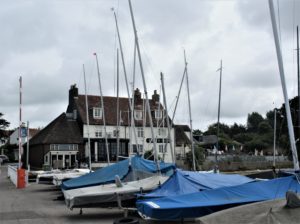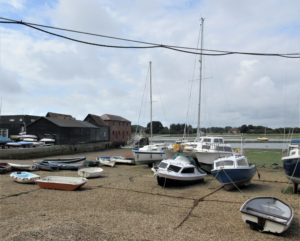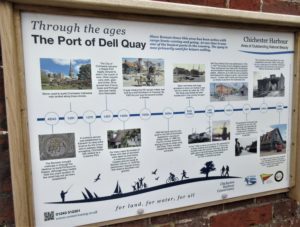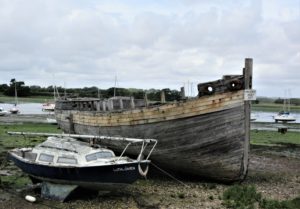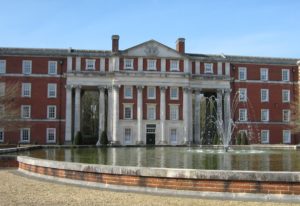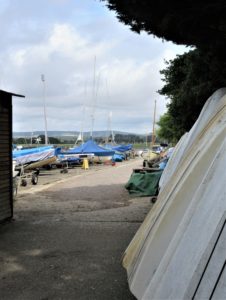As we walked along the wharf in the tiny isolated village of Dell Quay, taking in one of the largest marinas in the country, it seemed incredible that the Chichester harbour area in the pre-historic period would have been teeming with elephants, lions, bears and wolves all roaming freely.
Yet it is possible that early humans could have arrived here in this period. Flints from the Neolithic period can still be found on the shoreline today. There is evidence also for a Roman tile works near Dell Quay.
Today’s harbour during the Mesolithic period was 50km from the coast and sea levels much lower. A great deal of the water would have been locked into glaciers and freshwater streams would have run down from the Downs to the coast.
When the Romans were here, their galleys could have well sailed right up to where Fishbourne Palace stands, indicating that the palace could have well controlled the international traffic of the Roman Empire. It is probably the best preserved and largest Roman Palace in Britain and most of it, along with its estate, is buried under the village of Fishbourne, hidden from our eyes!
In the Middle Ages, sea levels in the harbour area were much higher than they are now and losses of land to the sea have been recorded. The Great Flood of nearby Apuldram took place in 1274, after which, extra sea walls and sluices were installed.
The wharf at Dell Quay was built in the 16th century by order of Lord Fitzwilliam of Cowdray. At that time the quay was the only official landing place for the Port of Chichester and in the 14th century it was rated as the 7th most important in all England.
Exports in the 14th and 15th centuries were mainly wool and cloth. Imports included cloth, coal, wine and building materials.
With no warehouses or inn in the early days, the people of Chichester asked permission to dig a canal from the quay to the town. This was granted, providing the canal did not infringe on lands belonging to William Howard, the first Baron of Effingham. As this was impractical, the Crown & Anchor Inn was built at the end of the 16th century. It seems it was originally called ‘Dell Key’ (Not to be confused with Dell Quay House which incorporates William Tipper’s post mill (a brick/stone roundhouse), which was the subject of Richard Nibbs and George Lambert’s paintings)
In the 17th century the channel needed constant attention, especially with ships offloading ballast as they approached the quay. After a great deal of dredging, ships of 40 tons could, in 1685 once again dock at the quay.
Coal from Newcastle, became the major import in the 18th century. There were three large coal pounds on the quay by the inn and on the site of what is now Quay Cottage. By 1908 there was a steam-driven crane which ran on rails and was later replaced by a diesel-powered crane.
With the opening of the Chichester Canal in 1822 goods could be taken directly into Chichester by barge. Of course, in later years this canal became the subject of a renowned 1828 painting by J.M.W. Turner – to be found in the Tate Collection
Moored boats were badly damaged in an awful gale in1925 which then led to the formation of Dell Quay Boat Club. In 1934, the name was changed to the Dell Quay Sailing Club. The Apuldram Fishing and Boat Club is now located at the quay and a classroom for the Chichester Harbour Education Centre.
Today, the water at Dell Quay is now normally only navigable for dinghies and small cabin cruisers, in keeping with the hours of the high tide.
The tall ship, Phoenix of Dell Quay, did however, visit twice during the second half of the 20th century. In 1991 she was converted to the 15th century Caravel Santa Maria for Ridley Scott’s film 1492: Conquest of Paradise. The ship was known as the Santa Maria until 1996 when she was converted into a 2 mast Brig, reverting to her original name (Phoenix of Dell Quay) as used as the ship Retribution in the Hornblower series 3.
If you are visiting Chichester, for Goodwood races, the Festival Theatre, or simply touring, take time to visit Dell Quay and reflect on it’s significant ‘early days’ of history as you feel the salty sea breeze , circling and wafting around you and the many small boats in their moorings.
The Sussex men that dwell upon the shoreline
Look out when storms arise and billow and roar,
Devoutly praying with uplifted hands,
That some well laden ships may strike the sands,
To which rich cargo they make pretence,
And fatten on the rich spoils of Providence.
(William Congreve 1670 – 1729)
